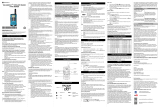ContentsContents
4
Contents
Safety and General Information . . . . 1
FCC Licensing Information . . . . . . . 9
Getting Started . . . . . . . . . . . . . . . . 11
Turning On/Off Your Radio . . . . . . . 11
Diagram of Your Radio’s Display . . 12
Installing Batteries . . . . . . . . . . . . . 13
Charging . . . . . . . . . . . . . . . . . . . . . 15
Diagram of Your New Talkabout . . 18
Operating Your T7000-Series Radio 19
Talking Range . . . . . . . . . . . . . . . . 19
Changing Your Radio’s Settings . . . 20
Accessing the Backlight . . . . . . . . . 21
Lock . . . . . . . . . . . . . . . . . . . . . . . . 21
Checking Monitor/
Signal Strength Indicator . . . . . . . 21
“Roger” Beeps/
Talk Confirmation Tone . . . . . . . . 22
Button Beeps . . . . . . . . . . . . . . . . . 22
Changing Settings . . . . . . . . . . . . . . 23
Setting the
Channel . . . . . . . . . . . . . . . . . . . . 23
Interference Eliminator Code . . . . 23
Eavesdrop Reducer (T7200 Only) 24
Call Tone . . . . . . . . . . . . . . . . . . . 24
Microphone Gain . . . . . . . . . . . . . . 25
Hands-Free Use/VOX . . . . . . . . . . . 25
Scanning . . . . . . . . . . . . . . . . . . . . . 27
Setting the Battery Type . . . . . . . . . 28
Battery Life . . . . . . . . . . . . . . . . . . . 29
Menu Functions . . . . . . . . . . . . . . . 30
Advanced Features . . . . . . . . . . . . . 33
Selecting Bandwidth . . . . . . . . . . . . 33
Advanced Features (T7200) . . . . . . 34
Understanding Repeater Channels 34
Setting Repeater
Channels . . . . . . . . . . . . . . . . . . . 35
Interference Eliminator Codes . . . 35
Scanning Repeater Channels . . . . . 36
Weather (T7200) . . . . . . . . . . . . . . . 37
Turning On Weather
Channel Reception . . . . . . . . . . . 37
Setting the Weather Channel . . . . . 38
Using Accessories . . . . . . . . . . . . . . 39
Use and Care . . . . . . . . . . . . . . . . . . 41
Frequency and Code Charts . . . . . . 42
Troubleshooting . . . . . . . . . . . . . . . 45
Motorola Limited Warranty . . . . . . . 48
6864110R94.book Page 4 Friday, February 8, 2002 2:34 PM


























